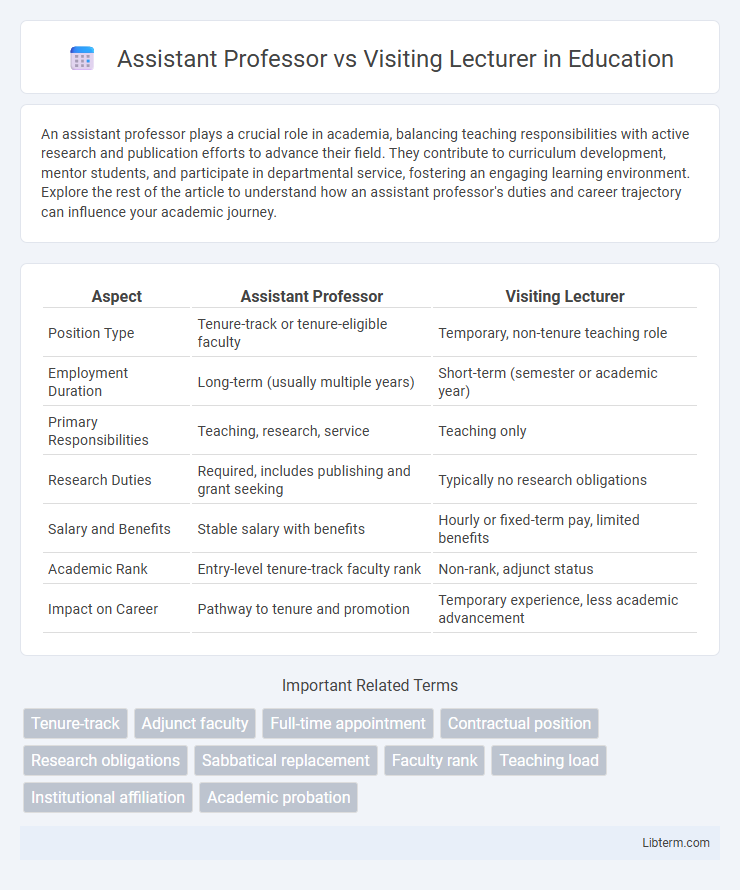An assistant professor plays a crucial role in academia, balancing teaching responsibilities with active research and publication efforts to advance their field. They contribute to curriculum development, mentor students, and participate in departmental service, fostering an engaging learning environment. Explore the rest of the article to understand how an assistant professor's duties and career trajectory can influence your academic journey.
Table of Comparison
| Aspect | Assistant Professor | Visiting Lecturer |
|---|---|---|
| Position Type | Tenure-track or tenure-eligible faculty | Temporary, non-tenure teaching role |
| Employment Duration | Long-term (usually multiple years) | Short-term (semester or academic year) |
| Primary Responsibilities | Teaching, research, service | Teaching only |
| Research Duties | Required, includes publishing and grant seeking | Typically no research obligations |
| Salary and Benefits | Stable salary with benefits | Hourly or fixed-term pay, limited benefits |
| Academic Rank | Entry-level tenure-track faculty rank | Non-rank, adjunct status |
| Impact on Career | Pathway to tenure and promotion | Temporary experience, less academic advancement |
Introduction: Understanding Academic Roles
Assistant Professors hold tenure-track positions with responsibilities in research, teaching, and service, often pursuing long-term academic careers at universities. Visiting Lecturers typically serve temporary teaching roles without tenure, focusing primarily on delivering courses and contributing practical expertise. Recognizing these distinctions clarifies career trajectories, expectations, and institutional commitments within academia.
Definitions: Assistant Professor vs Visiting Lecturer
An Assistant Professor is a full-time, tenure-track faculty member engaged in teaching, research, and service within a university, typically holding a doctoral degree and positioned at the beginning of the academic career ladder. A Visiting Lecturer is a temporary academic appointment, often part-time or fixed-term, focused primarily on teaching responsibilities without tenure eligibility or extensive research obligations. The distinction lies in the permanency, scope of duties, and career trajectory within higher education institutions.
Key Responsibilities of Assistant Professors
Assistant Professors primarily conduct original research, publish scholarly articles, and secure research funding while delivering undergraduate and graduate-level courses. They engage in curriculum development, academic advising, and serve on departmental committees to support institutional goals. Unlike Visiting Lecturers who often focus on temporary teaching roles, Assistant Professors balance teaching, research, and service duties as part of their tenure-track responsibilities.
Primary Duties of Visiting Lecturers
Visiting Lecturers primarily focus on delivering specialized courses, often bringing unique industry or research expertise to the institution for a limited term. Their duties emphasize teaching responsibilities, course preparation, and student assessment rather than long-term research or administrative commitments. Unlike Assistant Professors, Visiting Lecturers typically do not engage extensively in curriculum development, departmental service, or tenure-track research projects.
Hiring Process and Qualifications
Assistant Professors typically undergo a rigorous hiring process involving peer-reviewed evaluations, doctoral degree requirements, and evidence of research potential, often including publications and grant acquisition. Visiting Lecturers usually face a streamlined hiring process prioritizing teaching experience and subject matter expertise, often holding at least a master's degree but not necessarily a terminal degree like a Ph.D. The distinction in qualifications reflects Assistant Professors' emphasis on research credentials and long-term institutional commitment, while Visiting Lecturers focus on immediate instructional capabilities and temporary employment terms.
Job Security and Contract Length
Assistant Professors typically have longer-term contracts with a clear path to tenure, providing greater job security compared to Visiting Lecturers who usually hold short-term, fixed contracts lasting one semester to a year. Visiting Lecturers often face contract renewals without guarantees, resulting in less stability and higher employment uncertainty. The tenure-track nature of Assistant Professor roles offers more consistent employment benefits and career advancement opportunities.
Academic Rank and Career Progression
Assistant Professors typically hold a tenure-track or permanent academic rank, marking an early stage in a scholar's career with potential for promotion to Associate Professor and beyond. Visiting Lecturers usually occupy temporary or contract-based teaching positions without tenure eligibility, often focusing primarily on instructional duties rather than research. Career progression for Assistant Professors involves a structured path of research, publication, and service, while Visiting Lecturers may seek permanent roles or advancement through other academic appointments.
Research Opportunities and Expectations
Assistant Professors typically engage in substantial research activities with expectations to secure funding, publish in peer-reviewed journals, and mentor graduate students, contributing significantly to their academic field. Visiting Lecturers focus primarily on teaching duties with limited or no formal research obligations, and their roles often do not include securing grants or leading research projects. Research opportunities for Assistant Professors include access to institutional resources and collaboration networks, while Visiting Lecturers may have minimal access depending on the institution's policies.
Teaching Load and Course Assignments
Assistant Professors typically carry a balanced teaching load combined with research responsibilities, often teaching 2-3 courses per semester, including upper-level and graduate classes. Visiting Lecturers focus primarily on teaching with a heavier load, frequently assigned 3-4 undergraduate courses per term to fill immediate instructional needs. Course assignments for Assistant Professors may include curriculum development and advising, while Visiting Lecturers handle standard course delivery without extensive research obligations.
Salary, Benefits, and Professional Support
Assistant Professors typically earn higher salaries than Visiting Lecturers due to their permanent or tenure-track status and greater institutional responsibilities. Benefits for Assistant Professors often include health insurance, retirement plans, and research funding, whereas Visiting Lecturers may receive limited or no benefits depending on contract terms. Professional support for Assistant Professors includes access to mentoring, sabbaticals, and career development resources, in contrast to Visiting Lecturers who usually have fewer institutional support opportunities.
Assistant Professor Infographic

 libterm.com
libterm.com